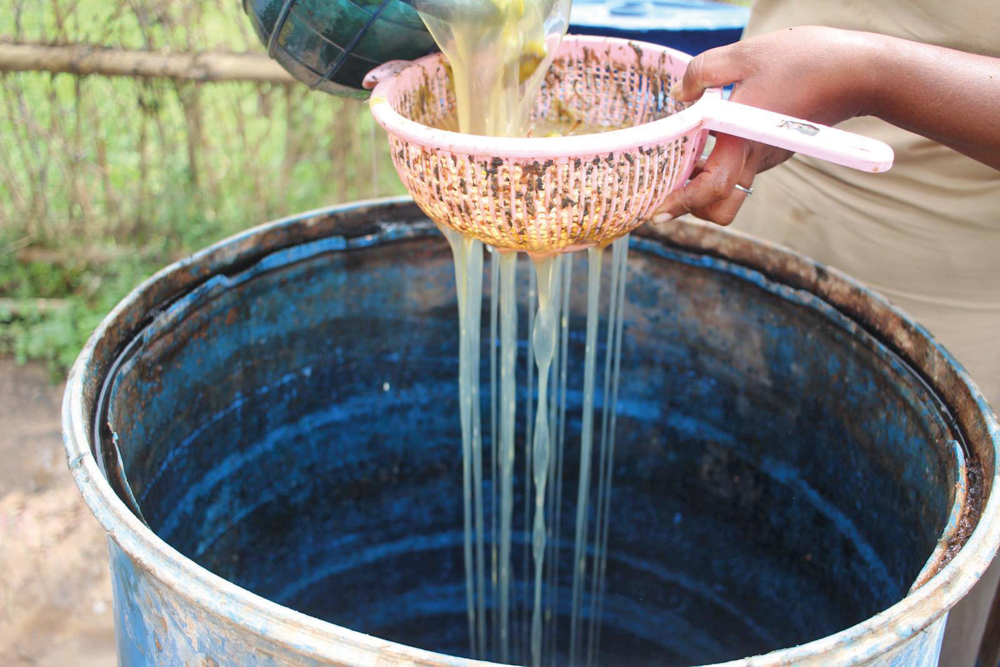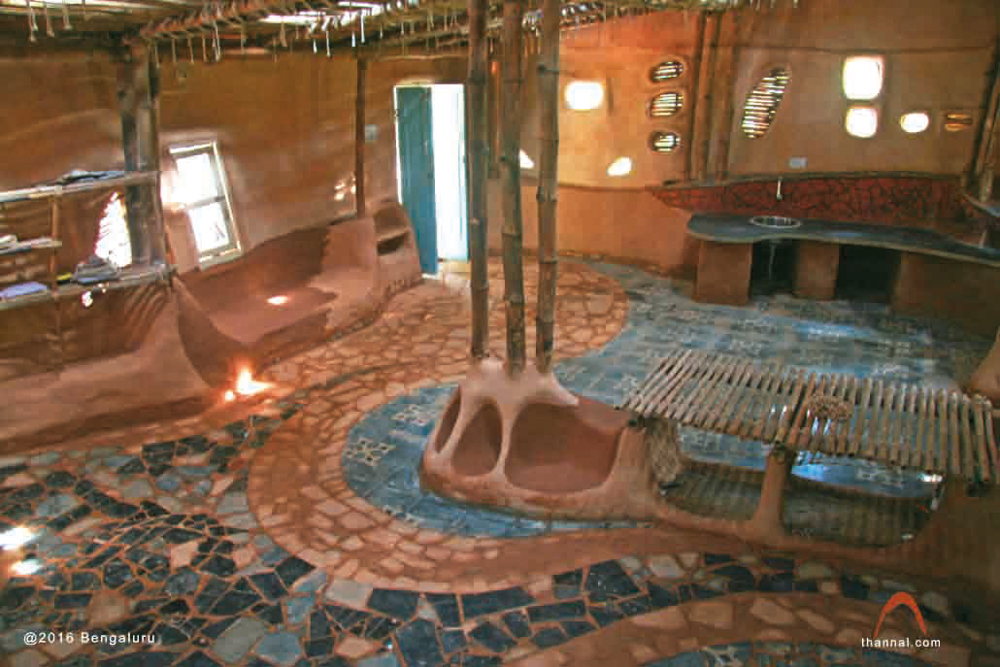Architecture
In the Lap of the Earth

Biju Bhaskar is promoting the concept of natural building through his venture, Thannal
Text Credits: Charishma Thankappan Image Credits: Thannal
Architecture does not just entail the construction of a building, but it is the setting up of a philosophy, thought process, values, and ideals. While conventional architectural models may be an inanimate block of concrete and cement that are ‘finished’ at the end of the erection; there are, however, alternate forms of edifices that are more alive through their symbiosis with nature. And Thannal is one such body that works for the assimilation of nature with human dwellings.

Biju Bhaskar worked in regular architecture for a long duration before quitting it ten years ago. He started Thannal in 2011 with the objective of trying to explore alternative architecture, which consists of green, sustainable, traditional, and vernacular architecture. “We do not compare our works with architecture, but we call it natural building. It’s a term that’s not well-known in the media. The natural building movement is gaining momentum internationally, but is not that progressed in Kerala,” he says. “We have to rethink the subject of mud architecture, which is in practice in Kerala currently, about whether we are doing it through pure sustainable methods,” says Biju, who specializes in mud architecture and operates in the village of Thiruvannamalai in Tamil Nadu.

Building homes was a community-based activity where if you wanted to build your home, your friends, family, neighbors – everyone – came to help you; but today that’s not the case, and one takes huge loans to build their homes. “Kerala is a state that has a large population belonging to the high-income group, so there is a huge potential of using your money to build your home sustainably,” observes Biju. “In the current architectural scenario in Kerala, none of the materials used in building homes is from your native land. Some of the others who proclaim building mud homes are not doing it through pure natural methods, as they are mixing cement with the mud, which lessens the quality of the mud.”
Accessible to all
The beauty of mud building is that it can be built for anyone, rich or poor; the difference comes only in the finishing, says Biju. “It has been only 90 years since cement came into Kerala, and today we are in a stage where people think that they cannot do without it. But don’t we see buildings that are over a hundred years old that are still going strong – temples, churches, manas, etc.? The concrete buildings of today can last only about 20 years before cracks start developing in it. No concrete building has completed 100 years in Kerala.”

A building’s walls are like the skin on your body – they are porous and have a breathing quality, says Biju. Only the buildings of olden times had such walls and construction; they kept the building naturally cool. “Today’s buildings don’t have such a quality, and instead make the interiors of the building hot. Enormous power is used through air-conditioning to keep it cool.”
Hand in hand with nature
Another focus area for Thannal is the communion of plants and buildings. “In our research, we have found that plants have a lot of importance in buildings. The bark and sap of plants can be used in various ways in the construction of a building.” And there is no bigger example for this than Biju’s own abode, which is an earthbag home. “It has about 12 varieties of herbal ingredients in it. So the air that passes through the walls is diluted with the essence of these herbs.” Biju points out that cement companies today are one of the major sources of air pollution. The paints used nowadays are also mixed with toxins that are dangerous to people’s health.

Biju says that there are a lot of positive changes happening in India and with the younger generation of architects for the past ten years. “The green movement in agriculture – organic farming, is coming along very well, what with the involvement of renowned people such as the actor, Sreenivasan. A lot of farmers come to meet us.” But at the same time, Biju rues another fact. “What is saddening is that villagers are lured by the urban living styles and moving towards it, discarding their natural means of life. So we are building free homes for them to bring them back to it and make them realise the importance of it.”
Towards growing more villages
Biju talks about his philosophy at Thannal. “We believe that instead of growing more towns, we should grow more villages because today, the times have changed, and one need not live in an urban scenario for sustenance. Villages and pure natural building should thrive.”
At Thannal, which Biju set up with his wife Sindhu, they give a lot of prominence to research and documentation. With the aim of growing more natural builders, they hold workshops to disperse the awareness. “We have created a hub called Natural Builders of India. Those who pass out have to complete a project in two years that is completely based on natural building. I also bring two-three projects as there are no examples for students in India. And at the end of the project, each student has to bring another student to enroll in it. So according to our calculation, the natural building movement is going to bloom in five years’ time in India. ”

Biju takes up only a maximum of two or three projects in a year. Receiving volunteers from all over India, their income is only from the workshops that they hold, claims Biju. A naturally built home of 500-1,000sq ft can be completed in four to five months. The costs, naturally, are always lower than conventionally built structures.
Thannal works across India and they choose villages after extensive studies. “In our travels, we discovered that all these people who are knowledgeable about natural building in the villages, are all 70-80 years old. We are trying to revive their knowledge, for which, we are living with a master mason every year. We use local people from the particular areas, as that way, there is exchange of information.”
Biju is an avid traveller and a devotee of Ramana Maharshi. Asked why he chose to settle in Thiruvannamalai, Biju says, “It is a place of gurus and a place for self-enquiry. It is one among the Pancha Bhoota Sthalam, and is symbolic of fire. And all gurus have taught that one should build mud houses.”
Architecture
Creating a Cozy Living Room: Tips for Comfort and Style

Your living room is more than just a space for entertaining; it’s a sanctuary where you unwind, relax, and spend quality time with loved ones. Creating a cozy living room involves a blend of comfort and style that makes the space inviting and functional. Here are some tips to help you achieve that perfect balance:
Choose the Right Furniture
Start with furniture that combines comfort and functionality. Opt for a plush sofa with deep cushions, perfect for lounging. Consider adding a cozy armchair or a recliner for additional seating. Make sure the furniture arrangement promotes conversation and allows for easy movement throughout the room.
Layer Your Lighting

Lighting plays a crucial role in setting the mood. Use a mix of lighting sources to create a warm ambiance. Combine overhead lights with floor lamps, table lamps, and wall sconces. For added coziness, incorporate dimmers or smart bulbs that let you adjust the brightness to suit different times of day and activities.
Add Textures with Throws and Pillows
Textures are key to a cozy living room. Layer different fabrics, such as soft throw blankets, plush pillows, and textured rugs. Choose fabrics like wool, velvet, and cotton that add warmth and comfort. Mix and match patterns and colors to create visual interest and a personalized touch.
Incorporate Warm Colors
Color influences the feel of a room. Opt for warm, neutral tones like beige, taupe, or soft gray for a calming effect. Accents in rich colors like deep blues, earthy greens, or warm terracotta can add depth and coziness. Use these colors in your furniture, accessories, and wall decor.
Use Rugs to Define Spaces

Rugs can help define different areas within a living room and add a layer of warmth underfoot. Choose a rug that complements your furniture and adds softness to the space. A large area rug can anchor the room, while smaller rugs can be used to highlight specific areas, like a reading nook or conversation zone.
Incorporate Natural Elements
Bring the outdoors in by incorporating natural elements. Plants not only add a touch of greenery but also improve air quality and create a calming atmosphere. Choose low-maintenance plants like succulents or snake plants if you’re not an avid gardener. Wooden furniture or decor pieces can also add a natural, grounded feel to the room.
Personalize with Artwork and Décor

Add personality to your living room with artwork and decorative items that reflect your style. Choose pieces that resonate with you, whether it’s family photos, abstract art, or vintage finds. Arrange decor items in groups to create visual interest and avoid clutter.
Create a Focal Point
A focal point helps draw the eye and creates a sense of balance in the room. This could be a fireplace, a statement piece of art, or a stylish coffee table. Arrange your furniture and decor around this focal point to enhance the room’s overall cohesion and appeal.
Invest in Quality Window Treatments
Window treatments can impact both the look and feel of your living room. Opt for curtains or blinds that provide privacy while allowing natural light to filter through. Choose fabrics that complement your decor and add texture, such as linen or velvet.
Add Personal Touches

Finally, make the space truly yours by adding personal touches. Incorporate items that have sentimental value or reflect your interests and hobbies. Whether it’s a collection of travel souvenirs, a beloved quilt, or unique decorative objects, these elements will make your living room feel more inviting and personal.
By thoughtfully combining these elements, you can create a cozy living room that serves as a comfortable retreat and a stylish gathering place for friends and family. Enjoy the process of making your space uniquely yours and revel in the comfort and warmth it provides.
Architecture
The Art of Feng Shui: Creating Harmony in Your Home

Feng Shui, an ancient Chinese art and science, is all about creating harmony and balance in our living spaces. By arranging our homes in accordance with Feng Shui principles, we can invite positive energy, known as “chi,” into our lives and promote health, wealth, and happiness. In this blog post, we’ll explore the fundamentals of Feng Shui and share practical tips for applying its principles to create a harmonious and inviting home environment.
Understanding the Basics of Feng Shui:
Feng Shui is based on the concept of “chi,” or life force energy, which flows through our environments and influences our well-being. The goal of Feng Shui is to create a harmonious flow of chi by arranging our surroundings in a way that promotes balance and harmony. This includes paying attention to the layout, orientation, and organization of our homes to optimize the flow of energy.
The Five Elements of Feng Shui:
In Feng Shui, there are five elements—wood, fire, earth, metal, and water—that represent different qualities and energies. By incorporating these elements into our home decor, we can create a sense of balance and harmony. For example, wood represents growth and vitality, while water symbolizes flow and abundance. By incorporating a balance of these elements into our living spaces, we can enhance the flow of positive energy and create a sense of equilibrium.
Applying Feng Shui Principles to Your Home:
Clearing Clutter: Clutter can block the flow of chi and create stagnant energy in our homes. Start by decluttering your space and getting rid of items that no longer serve a purpose. This will create space for fresh energy to flow and rejuvenate your home.
Balancing Yin and Yang: In Feng Shui, yin and yang represent the balance of feminine and masculine energies. Create a harmonious balance of yin and yang in your home by incorporating soft, nurturing elements (yin) with strong, active elements (yang).
Enhancing the Flow of Chi: Pay attention to the layout and arrangement of furniture in your home to optimize the flow of chi. Avoid placing furniture in direct line with doorways or blocking pathways, as this can disrupt the flow of energy. Instead, create open and inviting spaces that allow chi to circulate freely.
Incorporating Nature: Bring the outdoors in by incorporating elements of nature into your home decor. Plants, natural materials, and natural light can enhance the flow of chi and create a sense of vitality and well-being in your living spaces.
Room-By-Room Feng Shui Tips:
Living Room: Arrange furniture in a circular or semi-circular layout to encourage conversation and social interaction. Use soft, natural fabrics and incorporate elements of wood and fire to create warmth and intimacy.
Bedroom: Position your bed diagonally across from the door to command a clear view of the room while you sleep. Keep the space under your bed clear and clutter-free to promote restful sleep and relaxation.
Kitchen: Keep your kitchen clean, organized, and clutter-free to promote health and abundance. Incorporate elements of fire and earth, such as candles and earthy tones, to create a warm and inviting atmosphere for cooking and dining.
By incorporating the principles of Feng Shui into your home decor, you can create a harmonious and balanced living environment that supports your health, happiness, and overall well-being. Whether you’re decluttering your space, balancing yin and yang energies, or enhancing the flow of chi, the art of Feng Shui offers timeless wisdom and practical guidance for creating a sanctuary of peace and tranquility in your home.
Architecture
5 Sustainable Interior Design Trends to Embrace in 2024

As the world becomes increasingly aware of the importance of sustainability, it’s no surprise that eco-friendly practices are making their way into the realm of interior design. In 2024, we can expect to see a surge in sustainable interior design trends that not only enhance the beauty of our living spaces but also minimise our environmental footprint. From repurposed materials to energy-efficient solutions, here are five sustainable interior design trends to embrace this year.
Upcycled Furniture:

One of the most prominent sustainable interior design trends of 2024 is the use of upcycled furniture. Instead of buying new pieces, consider giving old furniture a new lease on life by refurbishing or repurposing them. From reclaimed wood tables to refurbished chairs, upcycled furniture adds character and charm to your space while reducing waste and conserving resources.
Biophilic Design:

Biophilic design, which emphasizes a connection to nature, continues to gain popularity in 2024. Integrating natural elements such as plants, natural light, and organic materials into your interior design not only enhances aesthetics but also promotes well-being and sustainability. Consider incorporating living walls, indoor gardens, and sustainable wood finishes to bring the outdoors inside and create a healthier living environment.
Energy-Efficient Lighting:

With a growing focus on energy conservation, energy-efficient lighting solutions are becoming a staple in sustainable interior design. LED lights, in particular, consume significantly less energy than traditional incandescent bulbs and last much longer, reducing both energy consumption and maintenance costs. Additionally, consider incorporating natural light sources such as skylights and large windows to maximize daylight and minimize the need for artificial lighting during the day.
Sustainable Textiles:

When it comes to upholstery and soft furnishings, opting for sustainable textiles is key to reducing environmental impact. Look for fabrics made from organic or recycled materials, such as organic cotton, hemp, bamboo, or recycled polyester. These materials not only reduce the use of harmful chemicals and pesticides but also minimize waste and support eco-friendly production practices. Additionally, consider investing in durable, high-quality textiles that stand the test of time, reducing the need for frequent replacements.
Smart Home Technology:

In 2024, smart home technology continues to evolve, offering innovative solutions for sustainable living. From smart thermostats that optimize energy usage to home automation systems that control lighting and appliances, these technologies can help reduce energy consumption and increase efficiency in your home. Additionally, smart home devices such as occupancy sensors and smart meters provide valuable insights into your energy usage, empowering you to make informed decisions about resource management and conservation.
As we strive to create more sustainable living environments, embracing these five interior design trends can help reduce our environmental impact while creating beautiful and functional spaces. Whether you’re upcycling old furniture, incorporating natural elements, or investing in energy-efficient technologies, every sustainable choice contributes to a greener future for generations to come. So let’s embrace these trends and make sustainability a cornerstone of our interior design practices in 2024 and beyond.
-

 Style11 months ago
Style11 months agoBridal Guide : Best Looks of Radhika Merchant Ambani
-

 Entertainment1 year ago
Entertainment1 year agoThe Stunning looks from Bhagya Suresh’s Wedding
-

 Fashion1 year ago
Fashion1 year agoMost Discussed Ajrakh Saree of Alia Bhatt
-

 Entertainment1 year ago
Entertainment1 year agoThe Most Stylish Guests of Bhagya Suresh Reception
-

 Entertainment1 year ago
Entertainment1 year agoBridal Bliss : All Bridal Looks of Swasika Vijay
-

 Movies1 year ago
Movies1 year agoA Nostalgic Journey Through Love &Cinema : Best Bollywood Romantic 90s Movies
-

 Fashion1 year ago
Fashion1 year agoMajor Denim Trends You Need To Know in 2024
-

 AD8 months ago
AD8 months agoPopular Curtain Fabrics to Consider for Your Home


































